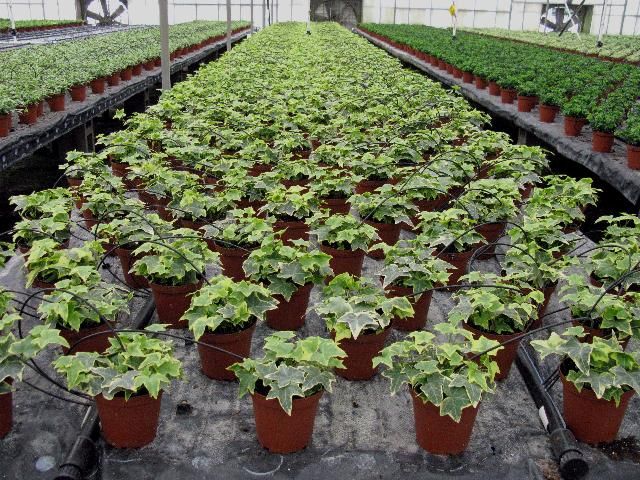Introduction
The genus Hedera belongs to the family Araliaceae and comprises about 11 species. Among them, H. helix, commonly known as English ivy, is native to temperate regions of Europe, northern Africa, and western Asia and is probably the most significant species used worldwide as a foliage plant. It is commonly grown as a potted (Figure 1) or hanging basket plant and can be used effectively in dish gardens and other combination planters. In large interior plantscapes, English ivy makes a good ground cover or it can be trained into formal shapes on trellises or made into topiary figures.

Two noticeable characteristics of English ivy are its evergreen leaves and the fact that it develops both juvenile and adult foliage. Juvenile leaves, usually 3- to 5-lobed, are produced on flexible stems that may form roots on every node while growing as a ground cover or a climbing vine. Adult leaves are produced on stiff, nonclimbing and rootless stems and are elliptic-lanceolate and not lobed. After adult foliage appears, flowers may develop in globose umbels, usually in compound panicles, with each umbel carrying 10–15 flowers.
According to the American Ivy Society (Naples, FL), ivy leaf shapes can be classified into nine categories in reference to the Pierot System: variegated (V), birds foot (BF), fan (F), curlies (C), heart-shapes (H), miniature (M), ivy-ivies (I), adult (A), and oddities (O) (www.ivy.org). Plants with different leaf shapes and variegation patterns, if stable in propagation, could potentially become new cultivars. The American Ivy Society is the International Registration Authority for new ivy cultivar registration. There are more than 200 cultivars of H. helix varying in leaf sizes, shapes, colors, and variegation patterns; all were selected from sports.
English Ivy is capable of adapting to a wide range of environmental conditions; it has been listed as an invasive plant in many states but not Florida. This article is intended to describe common species and cultivars grown in the foliage plant industry, provide guidelines for their culture and interior use, and list physiological problems that may be encountered during production and interiorscape use. It is suggested that the potential invasiveness of this species be noted at the retail level and that buyers be advised to only use this plant where it cannot become a nuisance.
Species and Cultivars
See Table 1.
Cultural Guides
Propagation
Juvenile English ivy is propagated by cuttings (Chen and Stamps, 2006); tissue culture is not currently used commercially. Both tip and nodal cuttings root readily with single node cuttings more commonly used commercially than double node cuttings. Cuttings are rooted singly in cell plugs but multiply in 4-, 6-, or 8-inch pots. The rooting media can be formulated by using 40% to 60% Canadian peat combined with an equal volume of perlite and vermiculate. Media should have good water-holding capacity and aeration, with soluble salts between 1-3 dS/m and a pH of 5.5 to 6.5. Cuttings root best under mist in a shaded greenhouse or shadehouse under a light level of 1000–1500 fc and temperatures between 70°F to 86°F.
Production
The best quality English ivy is produced if temperatures are between 70°F and 90°F and the relative humidity is between 60% and 100% (Chen et al., 2005). Plant quality and growth rates begin to decline when day temperatures routinely exceed 95°F or night temperatures drop below 65°F. Controlled-release or water-soluble fertilizers, or a combination of both, can be used for ivy production. A fertilizer with N-P2O5-K2O ratio at 3-1-2 or 2-1-2 should be used at the rate of 25 pounds of N per 1,000 square feet annually. Table 2 provides a guide for determining if English ivy is appropriately fertilized based on leaf analysis. Light intensity should range from 1500 to 2500 fc. The media should dry slightly before re-irrigating as plants grow poorly if the media is kept extremely wet or dry. Xanthomonas leaf spot disease may occur if overhead irrigation is used.
Shipping and Interior Care
Use protective sleeves when shipping finished H. helix. High quality plants will be retained if shipping temperatures can be kept between 50°F and 60°F. Once plants are placed indoors, it is advisable not to re-pot or fertilize them for about four weeks. This allows the plant to recover from any shipping stress. Plants should not be fertilized if soluble salts are 2.0 dS/m or higher. If soluble salt levels are greater than 3.0 dS/m, leaching the media with water may help reduce potential leaf necrosis or damage to the root system. Keep the media moist during the first two to three weeks indoors, and then water less frequently. Whether plants are in hanging baskets or free-standing pots, English ivy will retain its aesthetic appearance under light levels as low as 100 fc if temperatures are kept between 70°F and 80°F. Pinch any long stems to promote a bushy growth habit. Overcrowded plants can repotted at any time of the year.
Physiological Problems
See Table 3.
Literature Cited
Chen, J., McConnell, D.B., Norman, D.J., and Henny, R.J. 2005. The foliage plant industry. Horticultural Reviews 31:45–110.
Chen, J., and Stamps, R.H. 2006. Cutting propagation of foliage plants. pp. 203-228. In Dole, J.M., and Gibson, J.L. (eds.) Cutting Propagation: A Guide to Propagating and Producing Floriculture Crops. Ball Publishing, Batavia, IL.